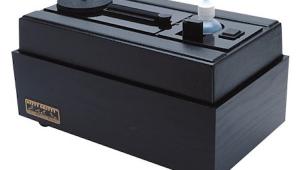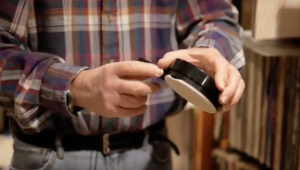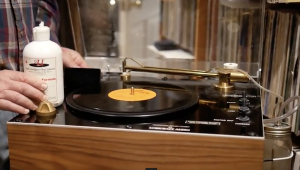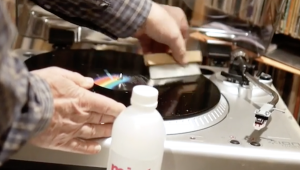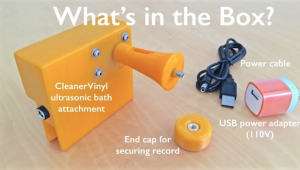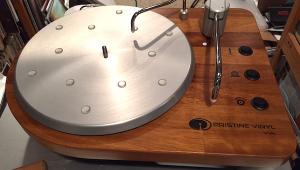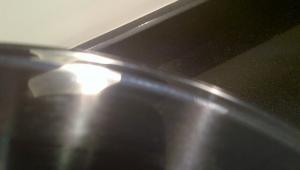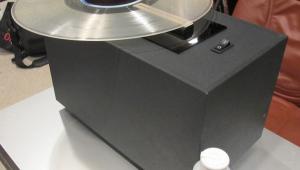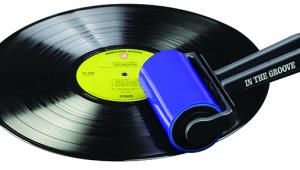Does the cleaner vinyl cavitation record cleaner, clean records as well as the more expensive cavitation record cleaners?
Cleanervinyl.com's Reasonably Priced multi-LP Cavitation-Based Record Cleaning System
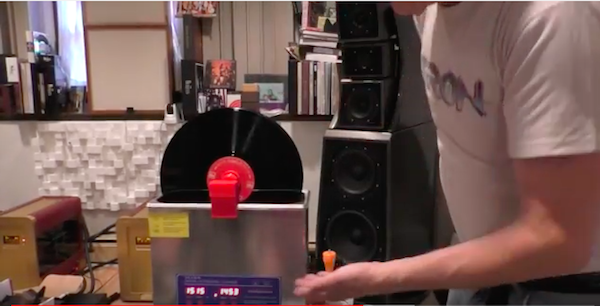
In other words, for under $700 you can have a cavitation-based record cleaning system capable of simultaneously cleaning up to a dozen records. This is the least expensive cavitation-based record cleaning solution we know of and it really works well.
I recommend reverse osmosis water. If you don't have an R/0 at home try Aquafina which is super-reverse osmosis treated tap water with no minerals added back (which is why you don't want to use Dasani). You can experiment with surfactants like Kodak Fotoflo to break up the water's surface tension or invent your own formula. One commenter said he used the Audio Desk additive in his own "home brew" machine. So there are many options.
- Log in or register to post comments


Drying the records with a hairdryer with ionisation function is much faster. Be gentle with the power though.

I have not tried drying records with forced air, but I and everyone who develops film knows that this is a big no-no. You are bombarding the media with household dust.

My brother in law did a few records with his ultra sonic (GT SONIC) and L'Art Du Son fluid in deminirealized water and works really well.
Again don't go full power and be sure you have an ionisation function.
The whole spiel will set you back about €150-200.

research and personal experience, the lesser expensive cavitation devices such a this one operate at about 40k hz. This will do a good job, but a machine that is 60k hz (or more) not only cleans better but is gentler on you records. The bad news is that a 60k hz machine is much more expensive and harder to find. The one I have is extremely quite though, unlike the 40k hz machine it replaced.
I also use the Audio Deske fluid added to my water, which does provide a better cleaning as well as making drying quicker, if air drying. I dry mine on my Nitty Gritty vacuum machine rather than air dry them.

Over the years 40-45 kHz was established as the laboratory standard for ultrasonic cleaning. The reason is that, while higher frequencies cause smaller bubbles, which in theory enables the cleaning of smaller features, the cleaning power is also reduced. For the features in record grooves the smaller bubble size is not much of a benefit, while the higher inherent cleaning power of 40 kHz makes for a cheaper ultrasonic cleaner (which is indeed a bit noisier...that is what we have garages for...;-). At 60 kHz one would need more power for the same cleaning effect, and that cost money.
With regard to potentially damaging records with ultrasonic cleaning, we have done several long-term tests where we exposed records to hours of cleaning, and no discernible effects were noticed (except of course a much better listening experience...;-). The case can be made that any mechanical method like brushes and the like will cause damage however. This damage is amplified by mechanical methods since dirt acts as an abrasive while the brush moves it across the record. In ultrasonic cleaning, on the other hand, nothing touches the record except active steam in bubbles and the dirt is directly moved into the cleaning fluid, so nothing is being dragged along in the groove by a bristle or similar object.

I bought the "Pro" model and dryer kit after Michael's first posting about CleanerVinyl. The inexpensive cleaner tanks are indeed very noisy, spending a bit more on a quieter unit will mean you can be in the same room during cleaning. The 40Khz transducers seem to clean just fine, upgrading to 60Khz or higher is a pretty big price jump from what I have seen.
Some commented that the 3D printed parts appear cheap or toy-like. I disagree. They are sturdy, well made, and thoughtfully executed. As Michael noted, they rest flat for easy loading/unloading of records. It's certainly not the no-muss-no-fuss solution of the AudioDesk or other models, but it's a more affordable option, and the results are amazing.
I've used a well-maintained Nitty Gritty for 2+ decades, and thought it was always a strong performer. This setup completely blows it away -- not even close. Records cleaned on the NG, that I thought sounded terrific before, sound significantly better after a trip through the CleanerVinyl process.

Which tank did you purchase and from where? Was it more expensive than the recommended one?

...but not intentionally.
I settled on a Sonix 4 68khz model, which performs at least as well in cleaning, but is much quieter and friendlier to operate. It was about 2.5x the cost of the base one (which runs about $160).
I did start with the one provided with the CleanerVinyl set, and although it worked, it made an awful noise and the heater broke after just a single cleaning. The CleanerVinyl seller was very prompt and offered to replace it ASAP, but I opted to get one from Sonix 4, which had good reviews.
With continued poor luck, Sonix sent the wrong one (40khz, not the 68khz I ordered). I ended up having that for 2-3 weeks, because Sonix couldn't ship the replacement right away. It was a clone in many ways of the one from CleanerVinyl. Same loud noise, but it worked. So I cleaned maybe 30 records with it, and they all sounded fantastic. I used earplugs when it was running/cleaning. (As Michael noted, the noise is not pleasant and can make it difficult to be in the same room with the cleaner when it's running).
The 68khz model arrived and it is almost silent in comparison. It is heavier, has a much faster heater, and adjustable power settings to control how much energy you put into the tank to clean, and you can vary it during cleaning. (Various forums have tons of comments about the pros/cons of this).
In terms of sound quality on the records, they all seem to provide the same result: instantly noticed significant sound improvement across the audio spectrum. Even just playing a silent groove on a record cleaned ultrasonically sounds noticeably different -- quieter overall, and the noise "footprint" is much leaner. I know, I need mental help for even noticing these things. That clearly lower noise floor is what I think makes the resulting music improvement so dramatic.
If you can handle the noise the cheaper cleaner makes, the they seem to work just fine. If you want a bit more refinement, and can afford it, the 68khz model is much better to live with -- you can even play the first batch of cleaned records while you're cleaning the second batch and easily hear the improvements.
I bought it direct from Sonix, which I think also sells on Amazon, and possibly other places.

CleanerVinyl doesn't manufacture the tank, and it's not his fault it failed. I think the one I got was just a dud. A friend in CA also bought the same set, with the base cleaner, and he's perfectly happy with it. To each his/her own.

I saw comment here about a lack of a filter, and users who dump the cleaning solution each time. I did the dump thing for several batches, and then looked into a filter. I have added a 3-stage external filter that is typically used with freshwater fish tanks, but can be made "high performance" with dense filter packs in each stage. It's hardly elegant, and took quite a bit of tweaking to dial in, but I now change the solution every 50 records or so, which is really more of a convenience, not a cost savings. I use distilled water, a bit of alcohol, and a drop or two of surfactant, so not expensive even if you dump each batch. People can go crazy with solutions - I have been plenty happy with what the above can do.
One other detail: I only clean 6 at a time now, with double spacers between the albums. Reduces efficiency but I felt 12 or even 10 at a time didn't get the same "wow" factor in the cleaning. Once you get familiar with the difference, you can tell which LPs have been US cleaned. US-cleaned records, to my ear, have a low-end whomp and top-end sparkle and air uncleaned ones don't.

Just my 2 cents, my Nitty Gritty sounds a lot like an upright vacuum cleaner -- a low/mid roar that gets annoying after cleaning 3-4 records. I've worn ear plugs for that, but not usually.
The noise from an ultrasonic cleaner is much higher pitch, and sounds like scraping or other metallic grinding (to my ear anyway). I couldn't take it for more than about 30 seconds without earplugs.
The level of this noise seems to vary from one cleaner tank to another, with less expensive models throwing off quite a bit of noise. I believe the operating frequency of the device also determines the level of noise, with higher frequencies resulting in lower noise. I may be wrong on that, but that's what I've read.

Rube Goldberg is alive and apparently working in audio. While the Audio Desk is a great product, if I had to use that new contraption I'd listen to CD's. That looks like a disaster waiting to happen.

Harry Weisfeld has done extensive testing on this subject. Him and Mat have concluded that ultrasonic cleaning can be done as DIY for pretty cheap so VPI won't make an ultrasonic cleaner. This was before this adapter came onto the market, so I guess this is as good as it gets. However, some pointers from Harry:
1) Dirt and loose vinyl bits on the used water flying around will damage the high-frequencies on the record to audible levels. After much testing he determined less than 10 minutes at 1RPM was best with mandatory water filtration between batches. Water filtration is achieved with a powered aquarium filter. Harry settled o this one:
https://www.amazon.com/gp/product/B00CVZJJ8Q/ref=oh_aui_detailpage_o01_s...
2) The best sound quality is achieved by drying the record in a vacuum dryer such as the ones VPI makes. This removes all loose dirt that was dissolved in the water left on the record.
3) Use a homemade solution of the purest water you can get, 20% 99%-pure isopropyl or ethyl alcohol and 3 drops of clear dish washing detergent.
You can read the whole very long thread in the vpi forums, but make sure to read through the whole thing, as experiments are conducted the recommendations changed over time:
http://vpiindustries.com/forum/viewtopic.php?f=9&t=2289&hilit=filter

I read that thread as well, and changed up my ultrasonic cleaning process as a result. That thread is a wealth of information from someone who not only has the means to experiment and has actually done it all, but also has the acute hearing ability to notice the results.
I now follow my ultrasonic cleaning session with a run through the record vac using clean water, and I've never had my records come out quieter. I now want to go reclean all of those I did with the vacuum alone, as I have struggled for decades trying to find a cleaning solution that works (they don't--they all suck), and a brushing method that can truly get into the grooves.
I've had to redo a few used records that were particularly nasty, but beyond that, the process works surprisingly well. And I don't go for that reverse osmosis nonsense either--that ultrasonic is a slurry of water and crud and whatever is used as a surfactant and/or detergent (I make up my own), and I use Aquafina on the vac as a rinse.
I can't stress the rinse-and-vac step enough. The ultrasonic loosens it up. Drying that onto the record is not helping matters. You need to rinse that loosened crud off of the vinyl. Harry W. even proved that out in his own tests--after the ultrasonic step, he would run them through the rinse/vacuum cycle and was draining out some nasty looking fluid when he was finished.
My only shortcomings? I need a better vac, and a better ultrasonic tank. Those cheap chinese ultrasonics are garbage, like the one I own. Good, reliable tanks cost around $400 and have a 60khz frequency that is known to clean better (smaller bubbles get deeper into the grooves). While these will only make small improvements, they'll get the cleaning to where I could not really improve on it further.

Yes, the PS-30A cleaner for which the CleanerVinyl attachments are designed is a well-priced unit made in China. Nonetheless it has proven to be very effective and reliable in its cleaning action. So the whole package is a well-priced way to get into ultrasonic cleaning. The discussion about 40 kHz vs. 60 kHz can be summed up as a trade off between penetration into small features vs. cleaning effectiveness. Higher frequencies generally need more power that lower frequencies to yield the same cleaning effectiveness (hence 60kHz systems are pricier for the same cleaning action). Higher frequencies generate smaller bubbles, which in theory can penetrate smaller features. 40 kHz has established itself over the decades as the best compromise for most cleaning tasks..

Does Cleanervinyl recommend using a cleaning solution or any additive or just plain water?

All vintage vinyl records are individual in the way they are contaminated. This means there is no recipe that works for all. All cleaning methods depend on the nature of the contamination ("soil") and the degree of it. A great portion of all records can be cleaned quite successfully in distilled water with ~10% of ethanol or isopropanol. The alcohol lowers the surface tension and also offers some degree of non-polar molecular moieties to dissolve greasy contamination such as fingerprints. If that does not work adding a few drops of a detergent can help. There are many special detergent recipes for vinyls out there, but in our experience simple dishwashing detergent works quite well. Add a run in pure water after using a detergent solution.

Michael or anyone
Care to comment on how this process and the results compare to the Klaudio and Audio Desk Ultra pricey / Ultrasonics
I have a Klaudio and love it
A nice less alternative to recommend to friends would be nice
Thanks

Ultrasonic cleaning depends on the power of the ultrasonic transmitter, the frequency of the sound waves and the duration of the cleaning process. The standard cleaner that the CleanerVinyl attachments are designed for has 180W cleaning power and 40kHz. The high end machines have similar wattages and frequencies, i.e. one can expect that the cleaning process is similarly effective. In general, lower wattage can be compensated by an appropriately extended run time. I.e. if you have a cleaner that has 50% of the power, run it twice as long, and the effect will be similar.

sorry just saw your video
that is an involved process
but lighter on the wallet

had to sell my system and the NG around 10 years ago.
Earlier this year, I got back into vinyl playback and now use 2 spray bottles and 2, directional clothes brush's to fix mold problems in some second hand vinyl purchases.
One spray bottle has biodegradable White board cleaner in it and the other,distilled water. I spray the LP's with the WBC first and spread it around with one brush.Leave it a minute,then spray the LP with the DW an use the other brush to spread that. I then use a hair dryer to evaporate the left over water and it has saved quite a few LP's.

What temperature did you set the cleaner to?
Any idea how many RPM's this turns the records?

RPM: The standard RPM of the CleanerVinyl attachments is about 3 RPM. We are currently putting the final touches to an accessory, the CleanerVinyl RPM, which will allow to reduce the RPM smoothly down to 0.5 RPM. This will enable vinyl enthusiasts to choose their own RPM settings. The RPM will be compatible with all CleanerVinyl attachments currently sold.
Temperature: In general, a 10 degree C increase of the temperature approximately doubles the effectiveness of a cleaning process. However, this needs to be balanced with the risk of warping your records at higher temperatures. Therefore, we recommend leaving the heater of the ultrasonic bath off. The ultrasonic transducer itself will somewhat heat the bath over time, and after a while the liquid becomes hand warm, which is perfect for the cleaning process.

This "new" cleaner is not equal to the other ultrasonic record cleaners such as the UltraSonic V-8 or the Audio Desk. The video seems to gloss over the operational aspects of the CleanerVinyl and emphasises the cheap price.
The lack of a filtration system and the lack of using filtered air are big problems. A shiny record may still sound bad if left with dirt that has not been removed.
The fact that you can jamb 12 records and get them into the tank does not account for the need to have more spacing in order for cavitation to work equally on all records. This cannot be offset by running the cleaner longer.
I manufacturer the UltraSonic V-8 and have done extensive testing on how
to get the best results.
Harry Wesfeld has used my V-8 for years along with many other industry leaders. I think you get what you pay for.

I have at least half a dozen record nerd friends with some combo of the V-8 solution, (cleaner and dryer, or just cleaner) and they absolutely LOVE it, and the gentleman who sells/supports them. I can't speak to sound quality, but the ease of use of that system would beat the CleanerVinyl setup.

I have been using the CleanerVinyl set up for several days now and have cleaned a hundred or so LPs 11 at a time. I have been using a Nitty Gritty machine up to now. The results with CleanerVinyl have been fantastic and noticeably better than my other machine -- I don't know how the results could improve much more. I do not reuse the cleaning solution; I dump it and put in a new bath after every 11 LPs cleaned (which is affordable given how little the CleaerVinyl set up costs). Rather than use the fan drying method that came with my CleanerVinyl kit for my last 11 batch, I used the Nitty Gritty vac to dry them off. Didn't notice a difference between the air dry method versus the vac method but I also use my equipment in a pretty dust free environment in my home. All in all, CleanerVinyl is providing what seems to be an effective product at a price that allows me to go to ultrasonic cleaning, and the results are excellent so far. All in all I would say it has a high QPR (quality-price-ratio).

I have cleaned 58 albums so far. They look and sound wonderful. I also use new solution for each batch. Set the temp to 27 C which is about 80 F. After the 45 minute drying cycle I do a distilled water rinse and vacuum with my VPI 16.5 RCM. Is that really needed, can't say, but I am confident my records are as clean as I could ever possibly want them to be. And they sound like they are. Can't thank Michael enough for posting the video and Clenervinyl for providing a great solution at an affordable price. I second the high QPR (quality-price-ratio).
My vote for one of the great bargains in high end audio.

Mold problems are common but it is important for homeowners to deal with them correctly. When mold is growing on a surface, spores can be released into the air where they can be easily inhaled. If you're sensitive to mold and inhale a large number of spores, you could experience health problems. To prevent mold problems and to solve it you can contact mold south florida professionals for detailed discussion and tips to avoid such situation.

I have a CleanerVinyl setup on the way, and I'm really looking forward to giving my vinyl an ultrasonic bath.

I was excited with the prospect of trying my CleanerVinyl Pro-Dry-RPM combo and impatient for it to arrive in Australia, but it got to me in 10 days! There was also a certain anxiety wondering whether the 1000 Aussie dollar cost of the components, ultra-sonic cleaner and liquids would result in markedly improved sound worthy of the investment. So when it did arrive I set to work immediately assembly everything and creating a batch of cleaning fluid from Reverse Osmosis water, L’ART du SUN and Ilfotol.
I grabbed 12 albums off the shelf and placed them on the spindle and did a 15 minute cycle at 30 degrees although, I’m not sure how accurate that temperature gauge is. Our ambient temperature here in Oz at the moment is about 30 degrees so it didn’t have to do much. It was fascinating to watch the micro bubbles go to work. I did find that the L’ART du SUN did produce quite a bit of frothing so I decided to do a second run of 15 minutes with an RO and Isopropanol combination 9/1. I had been put off Isopropanol by the person who sold me the L’ART du SUN as he said it could damage the vinyl. I decided to try it anyway because it is referred to by so many more learned people than me on these forum pages. I then did a final run of 15 minutes in just RO water to clean away any residues. I filtered the solutions each time I drained the tank and kept them for reuse.
Drying in Australian summer conditions was well under 45 minutes but I let it run to that time anyway.
I took the albums off and they looked shinny and black. There was a high water mark of film near the label as you would expect which I carefully removed before placing the vinyl into new inner sleeves.
Now to the moment of truth. I’d grabbed the last 12 albums at the end of my A-Z collection so it fell to Warren Zevon’s self-titled album and Excitable Boy and The Envoy to reveal whether I’d purchased well. A good choice really as I’d owned these albums for 30 years or more so knew them intimately.
Let me just say I listened to all three albums straight and the sound improvement was obvious and really quite astonishing. I heard details I’d never heard before and the sound stage was widened, clearer and delineated.
I couldn’t be happier with the initial results and investment (but will need to work on my cleaning solution formulae). This is a simple and cost effective solution to the best method of cleaning vinyl - through cavitation. As others have written, the results are as good, if not better, than any other component upgrade. If you have the system to hear it, this cleaning process will reveal whatever musical signal there is that is buried in those vinyl grooves.
If, like me, you are contemplating this pathway do not hesitate.

I purchased the Cleanervinyl Pro package and the recommended ultrasonic cleaner from Amazon a couple of months ago and have now cleaned about 200 records. My previous cleaning method was using the NittyGritty manual cleaner with my home vacuum. Records that I thought had been given a good cleaning and were a VG+ sounding at best now have moved into the Excellent or even Near mint category for sound. Soundstage is much clearer with more depth. Outer tracks which typically give the most issues with cleaning that still had crackle, in most cases now are clean.
After experimenting, I have found that I obtain the best results on the more used records with cleaning four at a time for about fifteen minutes. New records, I'll run six at a time that require less cleaning.
Overall, I would highly recommend this ultrasonic cleaning method and it has thoroughly convinced me that cavitation cleaning is the best method.

What other options are there for drying? Can I just air dry the records? Or use a lint-free diaper? Not sure I want to invest in the dryer along with everything else. At least not right away.

OK, all you audiophiles and/or stereophiles out there, here is my honest to goodness personal review of the Cleaner Vinyl ultrasonic record cleaning system.
I purchased the Cleaner Vinyl One several months ago in anticipation of the arrival of my new turntable (Mofi Ultradeck + M), which replaced my old stalwart of 45 years, a Philips 212. Yes! I’m that old! Along with the Cleaner Vinyl One, I also purchased a couple of their add-on adapters called Cleaner Vinyl Two so that I could clean 3 records at one time. I was tempted to go for the Cleaner Vinyl Pro, which cleans a lot more records at one time but wanted to try this technology, first, before investing that kind of cash. Of course, I also purchased an ultrasonic machine, which is required for this system. The Cleaner Vinyl One is, basically, the motor that turns the records in the ultrasonic bath. The entire package, including the ultrasonic machine, came to less than $400.00. Essentially, what you are buying from Cleaner Vinyl One is that motor and as many of their nifty attachments as you want. What you are also buying, of course, is their ingenuity, which, in my opinion, is well worth the price.
Here’s how I used the system: I started by cleaning a dozen, or so, of my 1960s and 1970s original pressings in Mofi’s Super Record Wash solution, which is nothing more than distilled water and a mild surfactant (no alcohol). You could make your own more cheaply, if you like, but I like Mofi’s stuff and I’m lazy. I then rinsed the records in a Knosti (same as a Spin Clean, only German) with distilled water. Then, I dried the records with high quality microfiber cloths and allowed them to air-dry further in Knosti’s record stand until I was certain they were completely and thoroughly dry. The last step was treating the cleaned records with Last record preservative. Keep in mind, here, that my record collection is in good shape. I’ve always stored the records properly, used anti-static poly sleeves, a Watts Disc Preener before every play in the old days, Discwasher D4 before every play in later days, hand-washed the records in distilled water & mild dishwashing detergent (no alcohol) occasionally and, basically, did everything I knew how to preserve them, short of rocking them to sleep in my arms. I’m sure I may have done some things I shouldn’t have or may have neglected to do some things I should have but I gave it my best shot with the technology I could afford along the way. The records were never played on anything other than the Philips with carts like modestly-priced Shures, Empires, Stantons, ADTs and others along the years, the styli brushed & cleaned occasionally (probably not as often as they should have been), never at more than 1.75 grams VTF (Baerwald geometry) and the Philips was always lovingly cared for. No one went near that TT but me! Of course, these records were played a lot over the years!
The results: the records came out shiny clean and looking new. Any trace of surface noise was completely and remains completely eradicated, even at 55% and 60% gain on a McIntosh MA 5200 and Paradigm Studio Monitor towers! Some clicks & pops remain but, again, these records have been played a lot over the many years I’ve had them. I intend to continue my research and trials, possibly with other cleaning solutions, to see if it might be possible to get rid of more of those annoying clicks & pops. I also intend to try cleaning some records, maybe even some I’ve already cleaned with this machine, and not using the Last treatment to see if that produces better results with the clicks & pops. If you folks have any suggestions, I’m all ears! I also intend to buy some new vinyl because of the way the Mofi Ultradeck + M makes them sing!
In conclusion, this Cleaner Vinyl system is the best damn record cleaning system I’ve ever used. It beats cleaning or washing records by hand, by a long shot. Although I’ve never used a vacuum cleaning system, I see no sense in spending that kind of money on a system that cleans only 1 record at a time, one side at a time and without the advantage of cavitation. I’ve also never used or heard the results of using one of those 4 or 5 thousand dollar ultrasonic machines either. However, since the technology employed (i.e. ultrasonic cavitation) is the same and one can only clean 1 record at a time on those machines, why would you want to spend that kind of dough when you could invest your money in a Cleaner Vinyl system at a fraction of the cost? You could use your extra cash to buy more vinyl! Also, the folks at Cleaner Vinyl (i.e. Rudy) could not possibly be more helpful, providing guidance, answering questions, etc. Visit their site (cleanervinyl.com) and see for yourself!
P.S. Prior to my purchase, I was a little apprehensive about the possibility of the record labels getting wet in the cleaning process and was prepared with a home-made version of label protectors, just in case. Rudy was right! As long as you use a modicum of care taking the records out of the bath after cleaning, this is not a problem at all.

All I can say is WOW. I have been using Disc Doctor manually for about 10 years. It works, but CV takes it to an entire new higher level. Almost all clicks and pops have been eliminated, dead quiet between songs. I have a VPI Prime with Sumiko Blackbird and Decware tube amp/preamp and DIY Decware 8" single driver speakers. Cables are from Blue Jean Cables. I have been listening to my new clean vinyl for about 12 hours yesterday and 10 hours today (I'm retired lol) - Lynn Stanley, Joni Mitchell, Michael Jackson, Bill Evans, Miles, Boss Brass, Getz, Wynton Kelly, Sonny Rollins, Harry James, Chicago, BS&T, Oscar Peterson, Stones, SRV - lots of 45 remasters in my collection - WOW - no noise, no pops and clicks.
I have the Lift-Pro and it worked fine from the getgo. I went crazy and cleaned about 1000 albums over 5 days - it works exactly as advertised. I purchased about 10 gallons of distilled water and 16oz of Kodak Photo Flo, and cleaned 10-11 records at a pop. i let them dry with the fan for 30 minutes and let them sit for about 15 minutes on a wood dish dryer that I found at a Dollar store years ago, which is perfect for vinyl drying. I had a couple that had a few drops after this, but 99% were dry after this process.
Thank you for an excellent product.


